January 2020 Second Issue WebCat

Early War True 4th Model Burnside Carbine.
20-01-15 A nice example of a true Fourth Model Burnside. For many years this pattern without a guide screw in the right side of the frame, was considered a transitional fourth model leading to the improved final pattern “late fourth model” with a guide-screw in the frame to guide the breechblock smoothly. Ed Hull’s research, however, established this screwless version as the true “Fourth Model,” first described by the Burnside Rifle Company as its “New Model” in mid-1862. This version incorporated several changes. One was to make the breech-block double-jointed, with a hinge in the middle. This kept the opening of the breechblock level with the top of the frame and the soldier no longer had to reach down between the side bars of the receiver with his fingers to insert or withdraw a cartridge. A second improvement was the use a breech pin rather than bolt, making it easier to remove the breechblock for cleaning or maintenance.
The company received a contract in June 1862 for 7,500 of this new 4th model and deliveries started in October 1862, reaching 5910 delivered by March 1863, and somewhere around 6910 finally delivered out of a total of about 7,300 produced, ranging in serial number from about 4,100 (end of the Third Model) to 11,400 (the beginning of the Fifth Model, as now known, which used the guide screw on the side of the frame to insure the breech block moved forward and up in the proper sequence.)
This gun has smooth metal and sharp wood that fits the metal tightly. The wood has good color and surface, with only very minor handling dings. Two distinct cartouches are still visible on the left wrist. The barrel has much lightly oxidized coverage of original blue turned plum color, with some wear spots where grey spots are present, as well as some very thin surface rust that will clean. Both sights are in place, including the leaf on the rear sight. The barrel band, sling bar and ring are in place, as is swivel in the stock. The lock, hammer, and latch parts show the typical mottled gray and bluish-gray of faded case colors. The frame, breech parts and trigger guard/lever, originally blued, are now a silver-gray with a few small darker gray areas forward. The barrel band shows a mix of bright and dark gray. The breech has the legible patent stamp, “Burnside’s Patent / March 25th, 1856,” which is just a little light on the second line. (The “Model of 1864” stamp applied by the company in 1863 started with with the Fifth Model.) The mechanism is good.
The only fault I find is a mismatched serial number. The frame is number 6710, giving it, and the gun, a manufacture date of December 1862 by Hull’s figures. The breech block is number 11131, probably dating to April or May 1863. Burnside Fourth and Fifth Models were widely used, third in number only to Sharps and Spencer carbines. It is not surprising that a block may have been switched out to repair a carbine damaged in service or perhaps accidentally switched by troopers cleaning their weapons together. One improved feature of the Fourth Model was its easily removable breech block which is completely interchangeable. We’re cleaning our rifles and have our breech blocks laying on a blanket on the ground. We swab out the bores, wipe out the powder residue caked inside the frames, apply a little oil if we have it, or maybe a little grease, we clean and oil the blocks and nipples… In the process you picked up my block, I grabbed yours… who knew? who would care? What difference would it make to anyone except a collector 100 years or more later.
(In 1945 a few US soldiers held a gun contest. During a period of boredom on board ship coming home, several of the men who had captured German Lugers as souvenirs decided to have a contest to determine who could assemble one the fastest. The pistols were all field stripped and the parts laid out in the middle of the contestants. Ready, set, go. At the end of the game not one man had a P-08 Luger with all matching serial numbers. The lesson being… Soldiers want guns that work. Collectors want guns that match.)
The Burnside is a key weapon in a cavalry collection, and this one dates before Gettysburg, where they were carried by the 12th Illinois, 1st MD, 1st NJ, 6th OH, 18th PA, and even by Custer’s 1st and 6th Michigan. $1,195.00 SOLD
Original Tintype Photo of Yankee Trooper with Burnside Carbine
The Above Image is for Illustrative Purposes Only It is not available for Purchase.
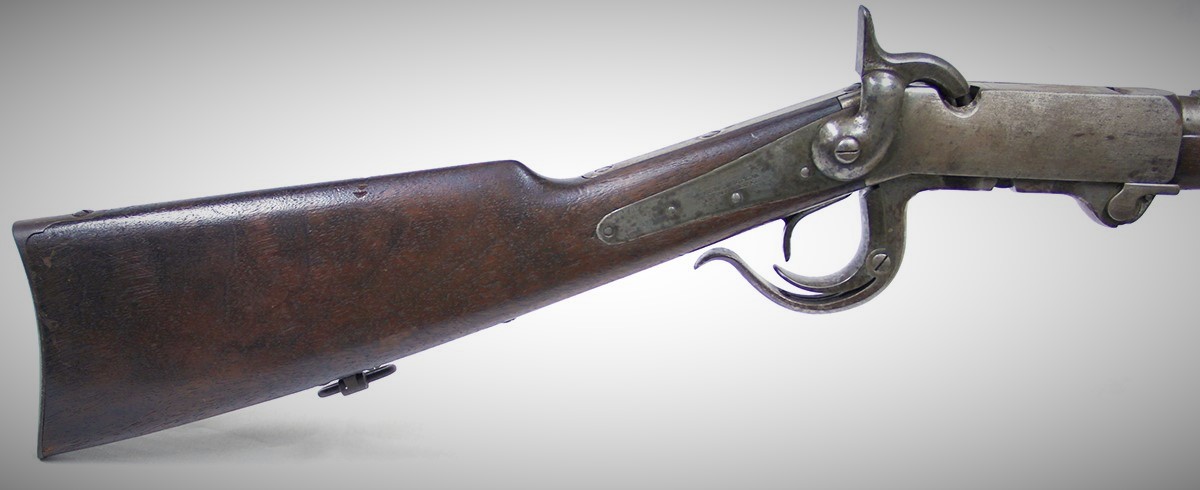
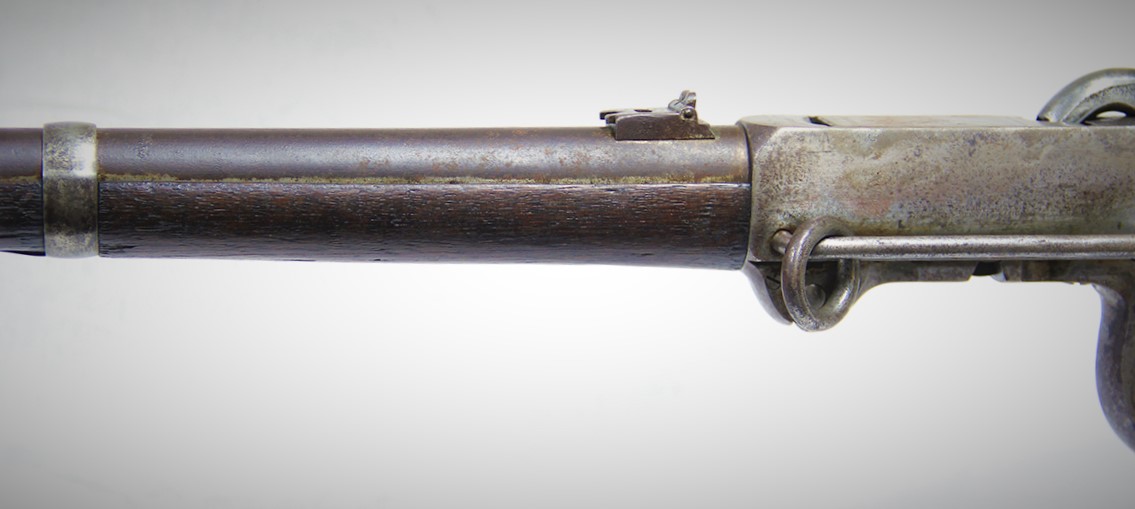

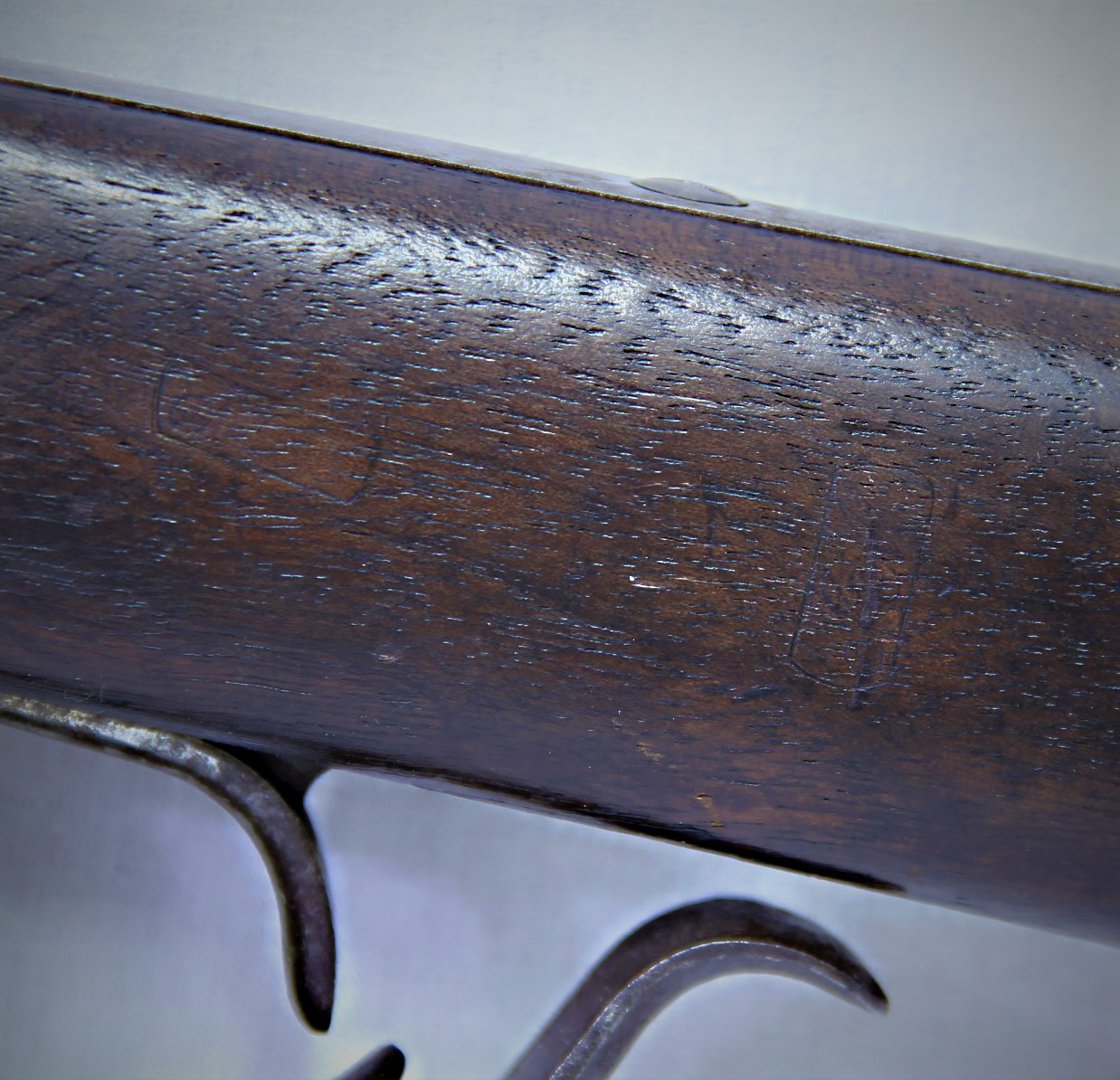
CDV Rochester NY Soldier in Wonderful Duster.
20-01-16 This full standing view is backmarked by Squiers of Rochester and has a period pencil identification of the subject as “Charley” written partially over the photographer’s logo on the reverse. There is no sign of a tax stamp, so it was taken sometime before Fall 1864. Charley rests his hand on the back of Mr. Squiers’ chair and holds his issue forage cap down at his side to show the viewer that he is a soldier, but not particularly interested in showing off about it. He has donned a decent necktie for the camera, but his footwear is obviously just “work shoes”. He is either wearing extremely heavy weight wrinkled denim trousers over boots, or he is wearing very tall false boots (half boots) over his shoes. We may be looking at heavy canvas or leather false boots. The deep creases and folds in the thick cloth or leather over his lower legs is very similar to what we see with well used boots. (Or dirty trousers saturated with horse sweat that have been worn for a week or so.) Charley also wears a plain light color duster which is a piece of clothing almost never seen in photographs, and which is generally associated with mounted service or cowboys. There is no insignia indicating his branch of service, but the duster and footwear tells me he is likely cavalry. The 8th New York Cavalry included a large number of men from the Rochester area. Perhaps our boy served with them in the desperate fights at Winchester and Gettysburg.. Or perhaps Charley just shoveled shit at some Army remount facility. I’ll let you choose. Neat photo $85.00 MOVED FORWARD TO MARCH 2020 WEBCAT

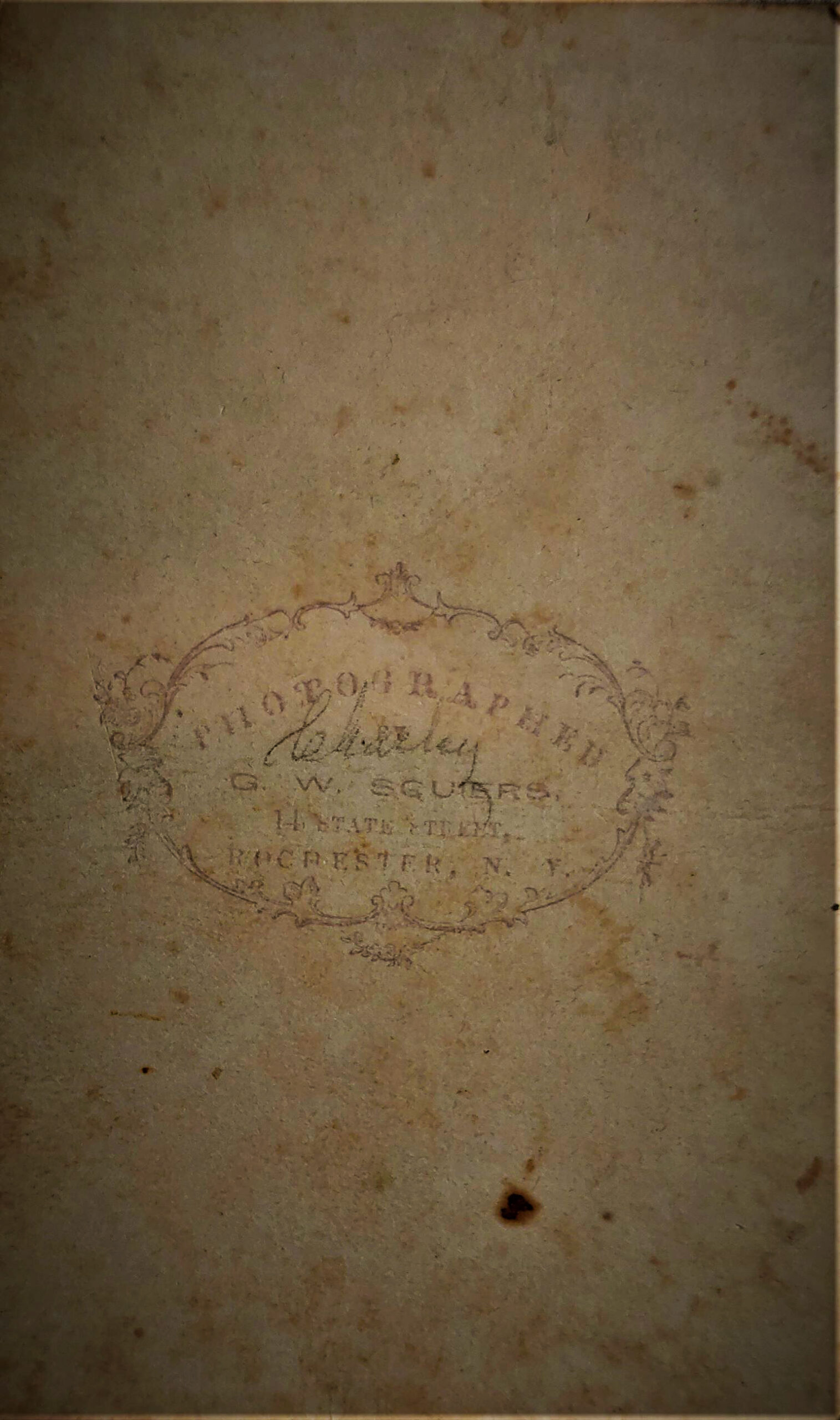
Wounded in Action Inscribed Sword
20-01-17 INSCRIBED 1850 FOOT OFFICER’S SWORD OF HENRY C. SELVAGE, 87th NEW YORK, WOUNDED IN ACTION AT FAIR OAKS This 1850 Foot Officer’s Sword is one of the imports brought in by American military goods dealers for sale to U.S. army officers. It follows the regulation pattern, having a brass hilt with open-work floral guard, a sharkskin wrapped grip bound with twisted brass wire, and an etched blade with floral military motifs. As is common, the blade maker’s stamps appear at the ricasso of the blade and the Coulaux Brothers / Klingenthal makers’ name is engraved along the top of the spine. No scabbard. Beautifully engraved on the inside of the counterguard in period script is “Henry C. Selvage / 87th N.Y.S.V.”
Henry Clay Selvage (1842-1901) was a student in the Class of 1861 at the Free Academy of New York (now City College,) when he was appointed first lieutenant in Co. E of the “McClellan Infantry.” This unit had incorporated several other companies and aspired to field service as a regiment, but then itself consolidated in October 1861 with the “Brooklyn Rifles,” which thus became strong enough to muster in on December 11, 1861, as the 87th New York Volunteers. Selvage accepted a second lieutenant’s posting in 87th (he is sometimes listed as a “brevet first lieutenant”) and was assigned to Co. G, officially enrolling in November 1861 and mustering in on February 19, 1862, listing himself as 21 years old. (The NY Adjutant General’s Office later regarded him as never having received a commission. It took until 1890 for the US War Department to declare him as (good as) commissioned 2nd Lieutenant (though of Co. A) on Feb. 19, 1862.)
The regiment left the state in December 1861, trained in Casey’s provisional division and then joined the 3rd Army Corps in March 1862, on the eve of McClellan’s Peninsular Campaign. As part of Jameson’s Brigade of Kearny’s Division it there took part in the seige of Yorktown and the Battle of Williamsburg. On May 31 Selvage was wounded in the first day’s fighting at Fair Oaks when the Confederates attacked McClellan as his army lay divided by the Chickahominy River, the 87th losing 76 men, killed, wounded or missing in the fighting.
Selvage was given the opportunity to recover at home by being assigned to recuiting duty on June 13. Like other officers in the unit, Selvage was officially mustered out September 6, 1862, the date the regiment was consolidated, but in another tribute to paperwork was not actually relieved from recruiting duty until September 29.
After his service Selvage worked as a clerk for a New York importer. He lived in New Jersey. He married, had two sons, served in some civic posts and was a member of the Loyal Legion. He died in 1901 and is buried on Staten Island. This sword was really there. $2,350.00 SOLD
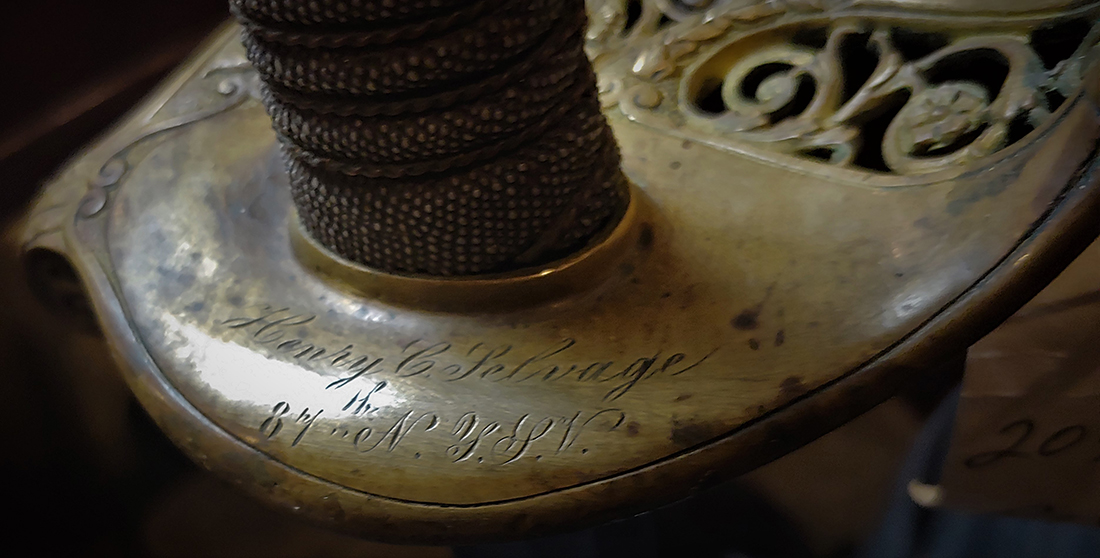
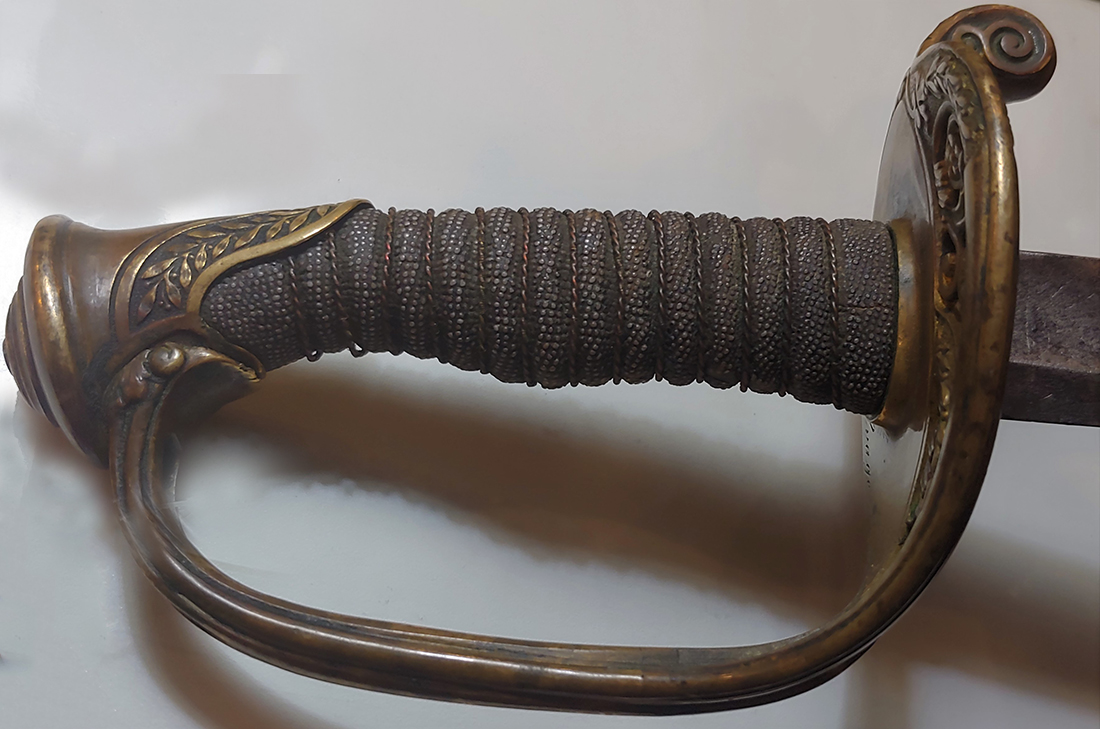
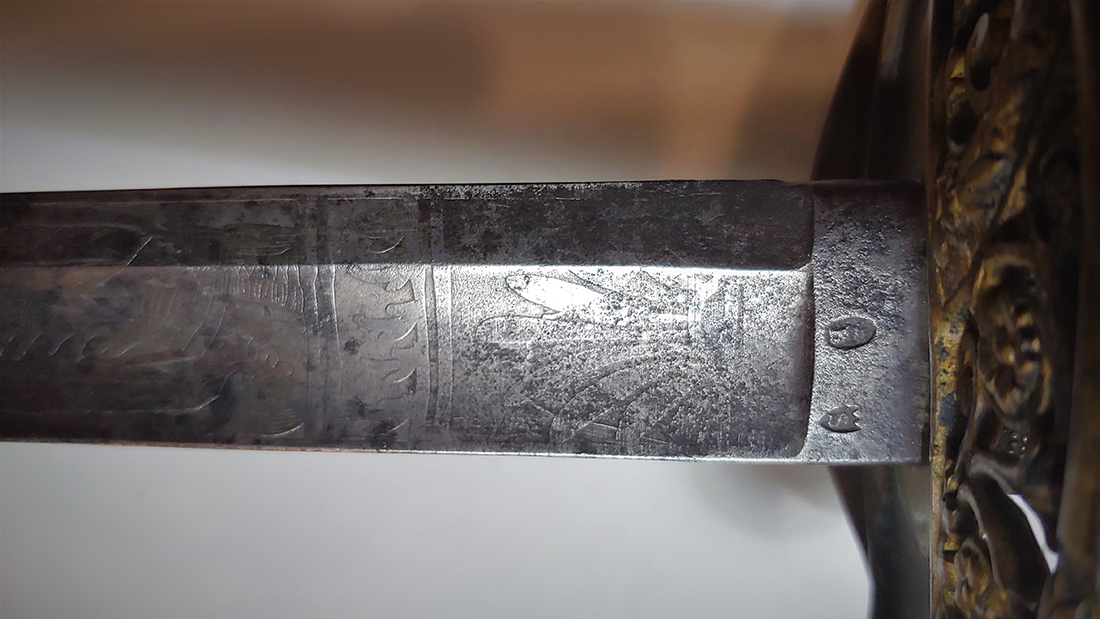

Colt Open Top .22 cal. Saloon Girl Gun w/ Blue!
20-01-18 The Colt Open Top Pocket Model Revolver was a single action revolver introduced by the Colt’s Patent Fire Arms Manufacturing Company in 1871. Introduced a year before the large bore Colt Open Top (a model from 1872) and two years before the Colt Peacemaker the Colt Open Top Pocket Model Revolver was one of the two first metallic cartridge rear-loading revolvers manufactured by Colt’s. Popular with gamblers and saloon girls it was easily concealed in a pocket or garter holster. Overall fine condition with much original factory blue finish still remaining. 100 % original, 100% complete, and mechanically perfect. VG grips showing a little wear. Frequently found with nickel finish, these blued examples are far more desirable than their shiny silver cousins. A great early Colt. COLT! $550.00 SOLD
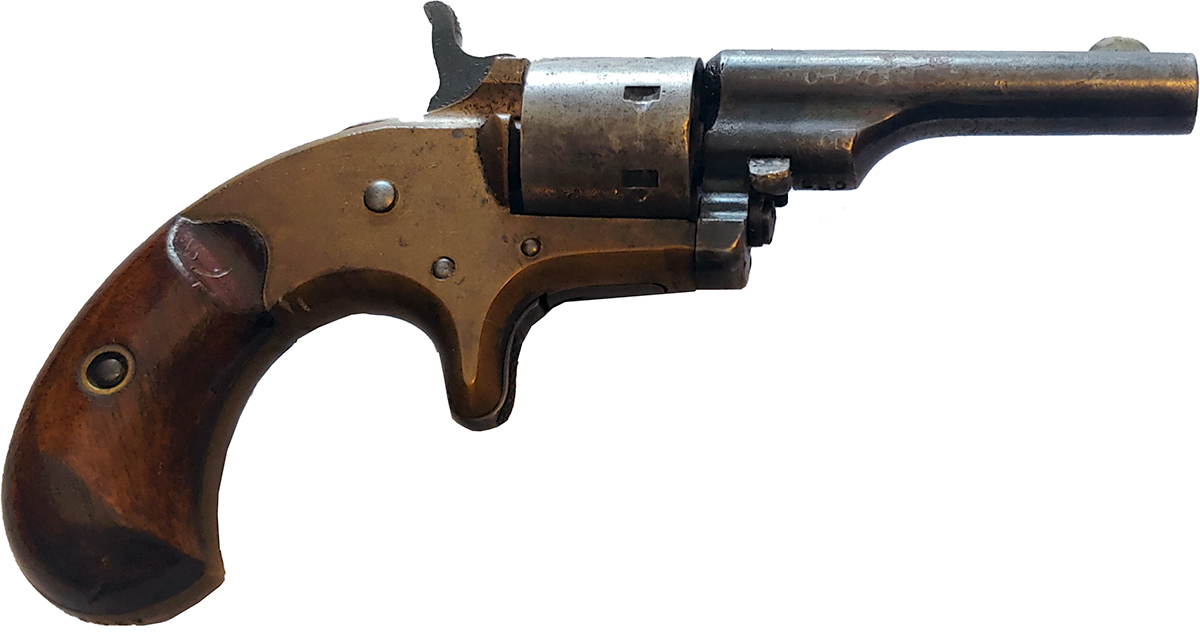

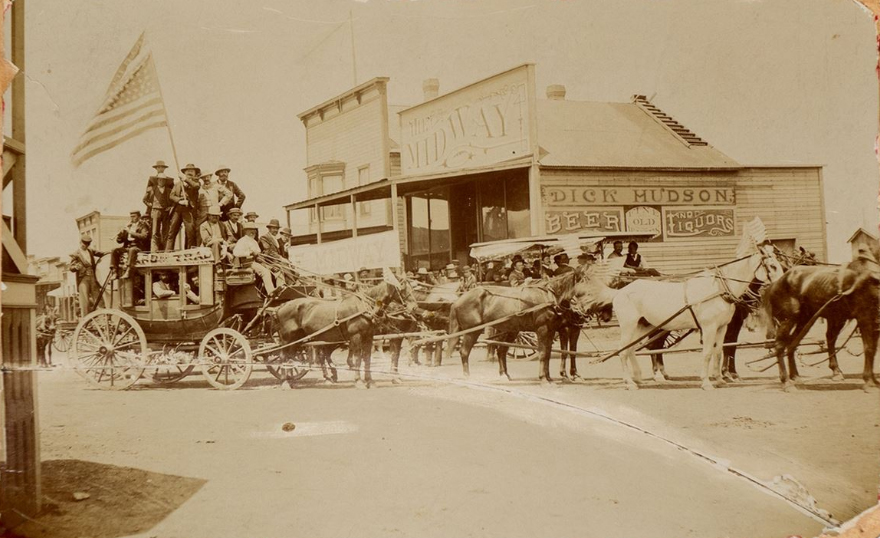
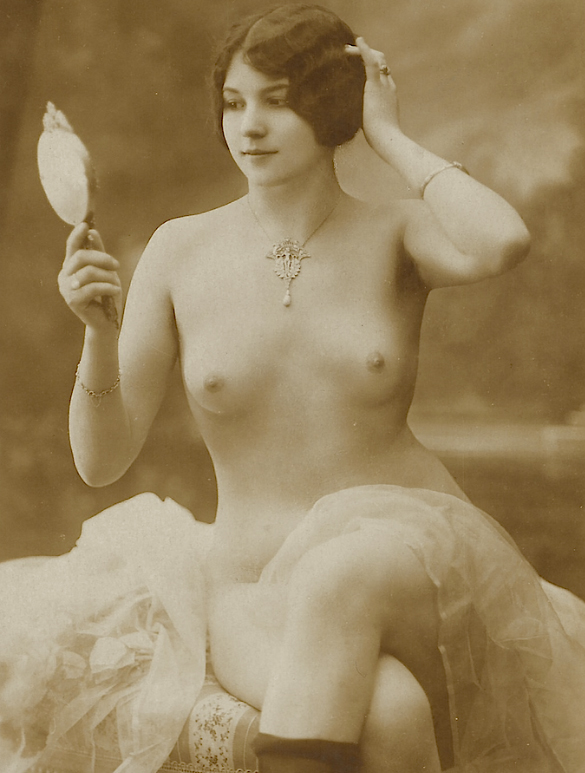
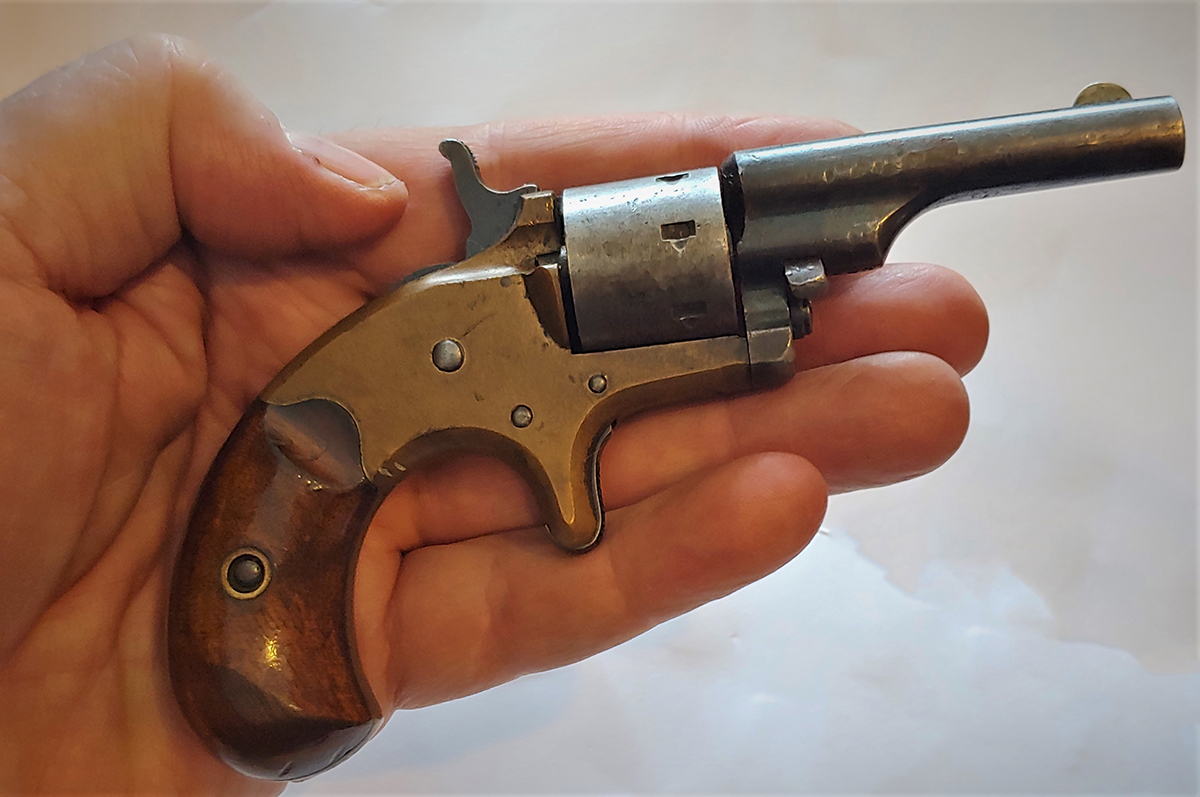

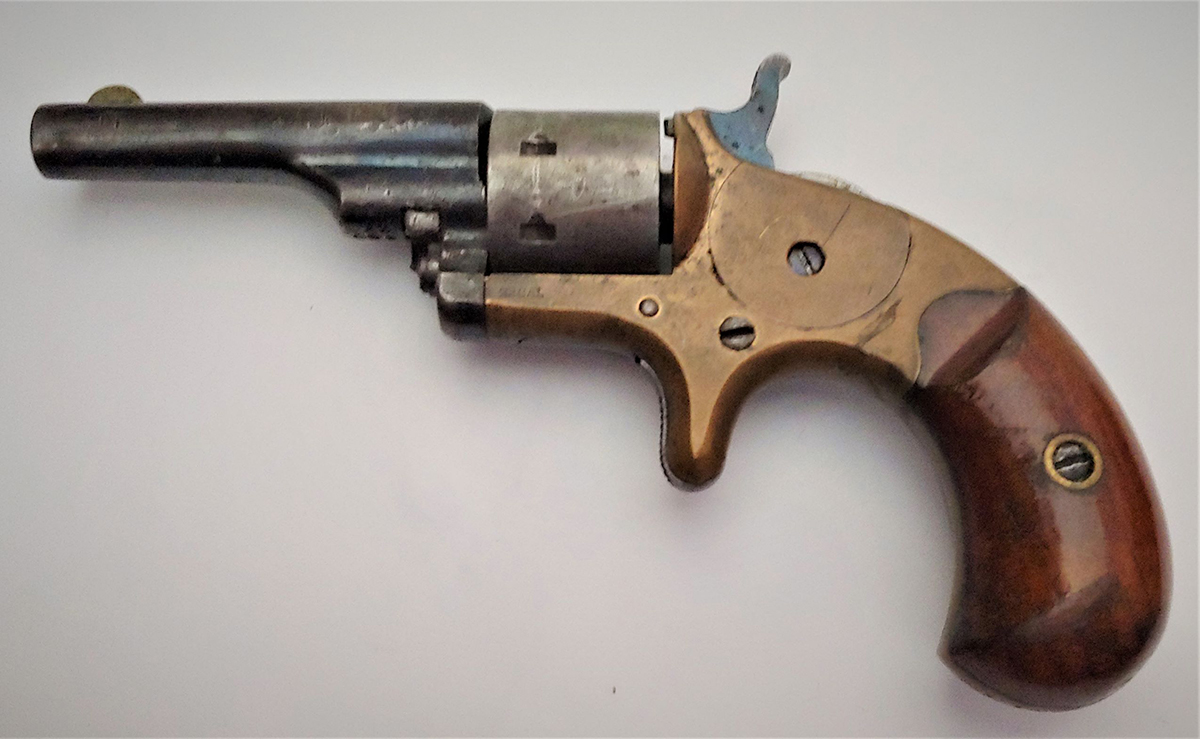

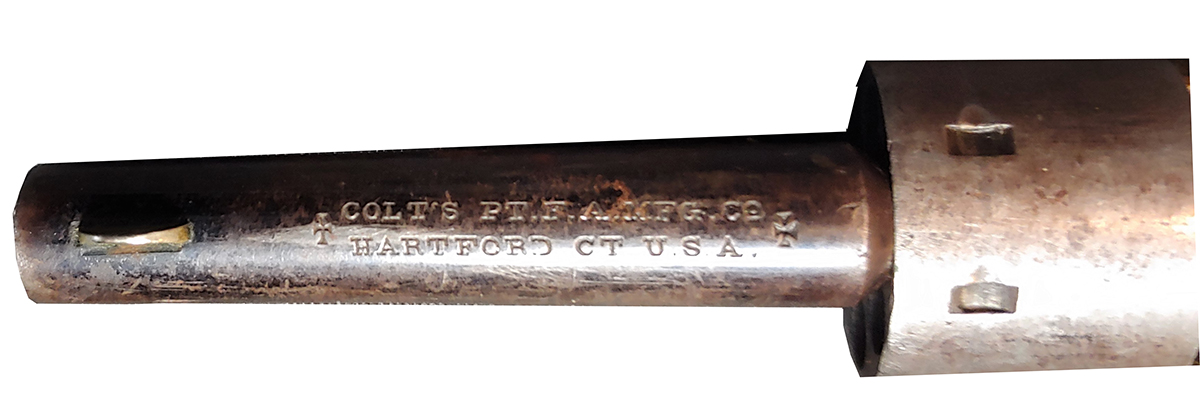
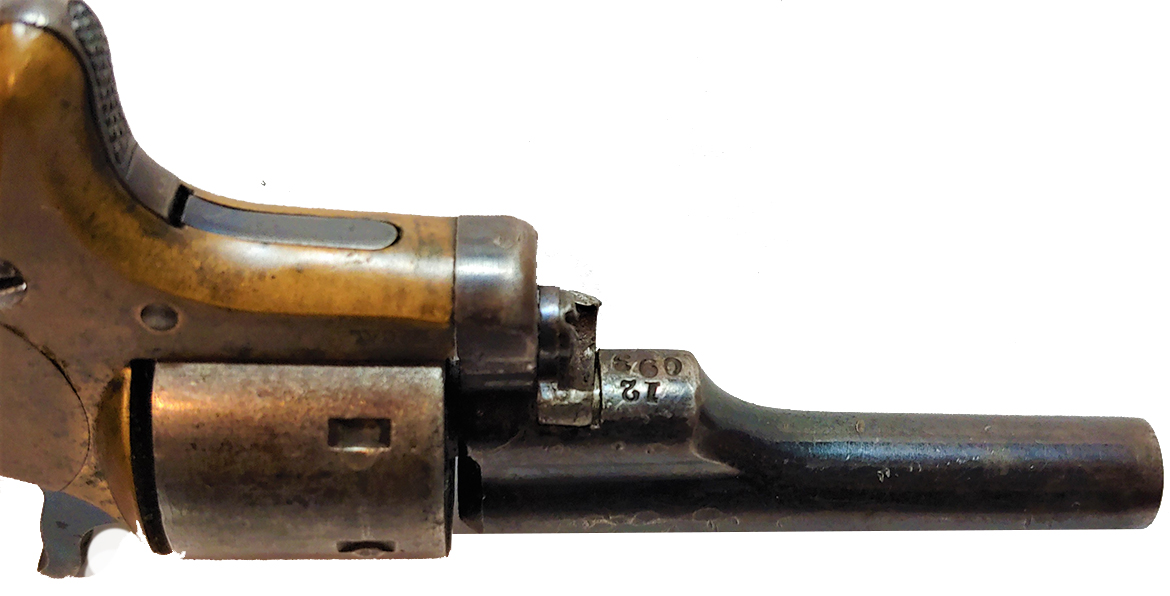
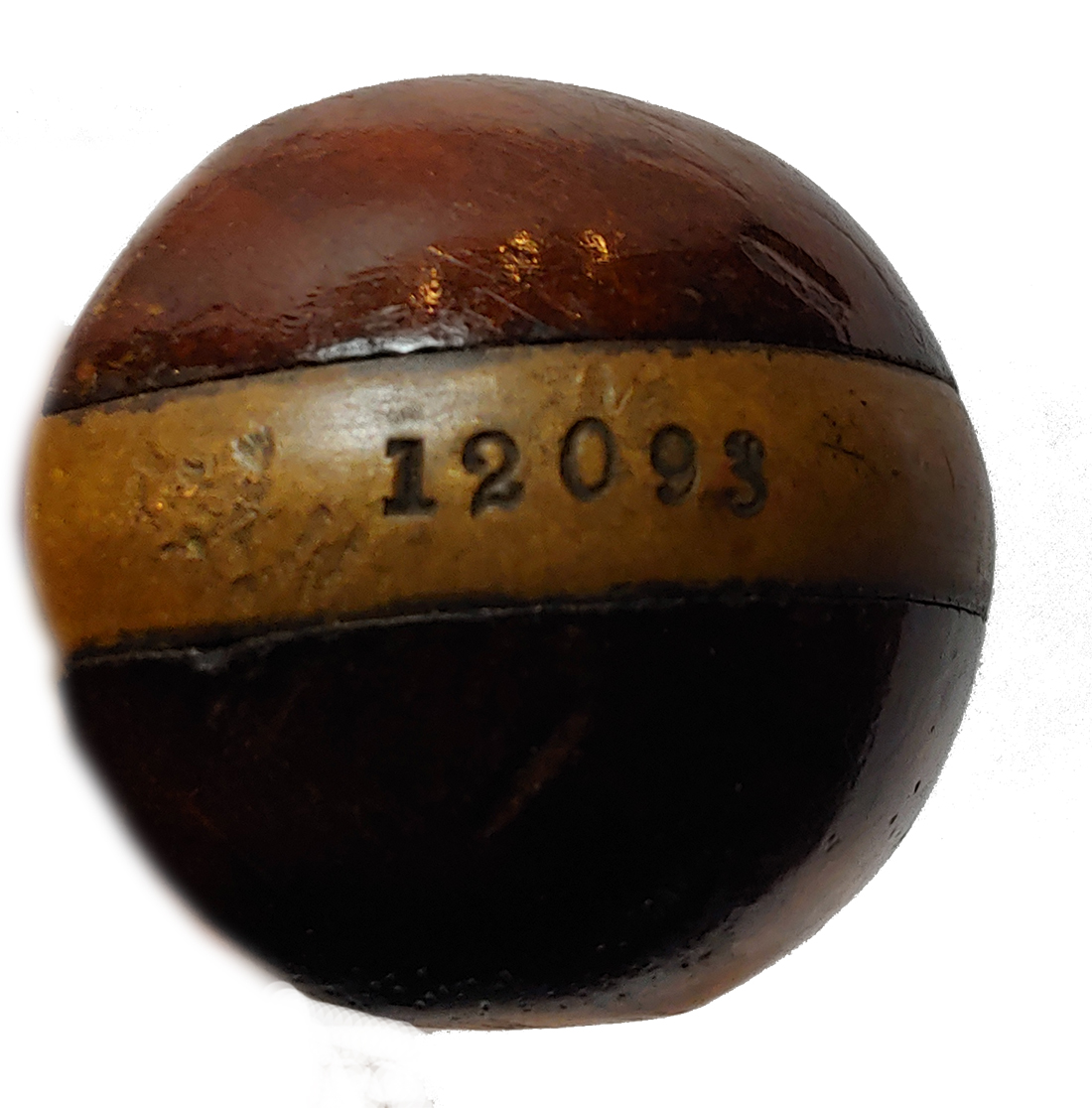
Extra Fine & Complete Cap Box
20-01-19 This is one of the old time MINT SURPLUS 1864 cap boxes that were available BRAND NEW for 50 cents one hundred years later, in 1964. This one is in extra fine condition for now being nearly 160 years old, with just some light age crackling in the black finish. The finish is completely stable, and not flaking now. It was made by S H Young and Company and is so marked on the inner flap. The outer flap has a bold inspector’s cartouche. The interior of the box is as new. Here is one heck of a friendly price for one of these in this condition. #$165.00 SOLD
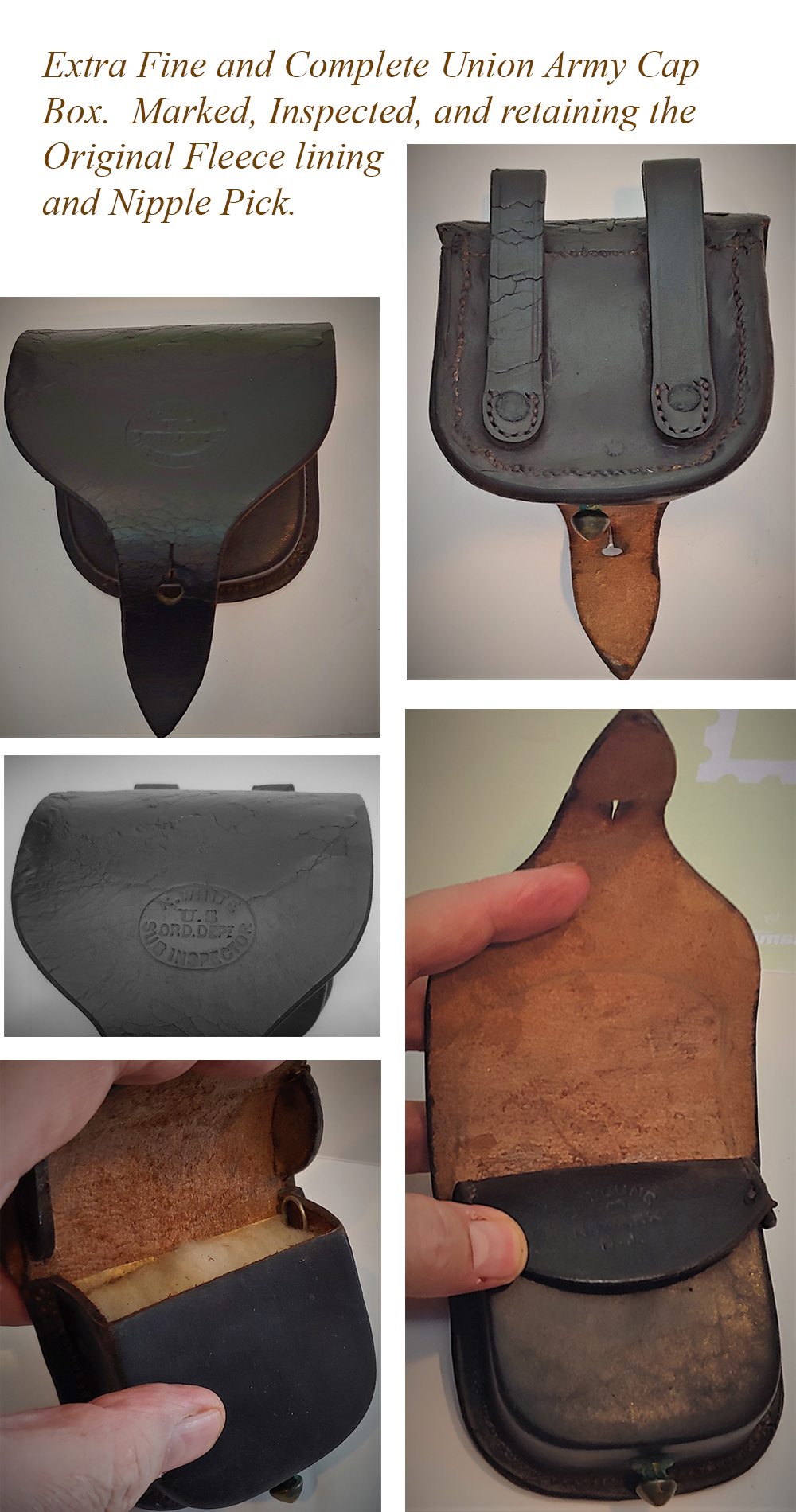
Allen & Wheelock Cartridge Revolver
20-01-20 ALLEN AND WHEELOCK BRASS FRAME .32 CALIBER SIDEHAMMER REVOLVER Allen and Wheelock made only about a thousand of these side-hammer revolvers in .32 caliber from 1859 to 1862, but they made up for the limited quantity by having a large number of variations within the short production run. Flayderman shows only three models, but mentions at least eight distinct types. This one measures 8 ½ inches overall and has a 4-inch octagonal barrel. Like most of this pattern it has no engraving on the cylinder. Unusually, though, it has a brass frame, which Flayderman considers “rare.”
The left barrel flat has sharp markings: “Allen & Wheelock Worcester MS. U.S. / Allen’s Pat’s Sept. 7. Nov.9, 1858.” The forward part of the frame has the correct “July 3, 1860” stamp, with just the last two digits rubbed. The front sight is in place. The barrel is smooth metal with only one or two very minor dings, shows some bright metal, but is mostly light gray mixed with a dusty brown, matching the cylinder and hammer. The brass frame has a nice, aged patina showing a dark areas next to the cylinder and screws, but pleasing overall. The grips are good, with a tight fit to the frame and a gradually curving drop. They show some wear and rubbing on the upper right where a collector colored them a bit, but on the left preserve their finish and have an ancient museum inventory number “1” on a paper label that we have left in place as part of the history of the gun. The cylinder pin enters from the front, as is correct, and has a flat rectangular button head and short latch. The mechanics are good.
These pistols were popular personal arms for civilians and not a few soldiers. They sometimes show up cased, but were obviously meant for convenient carry in a pocket and have a spur trigger that won’t get tangled up if the owner had to get it out in a hurry. Overall VG. 100% original. 100% complete. Mechanically perfect. $595.00 SOLD


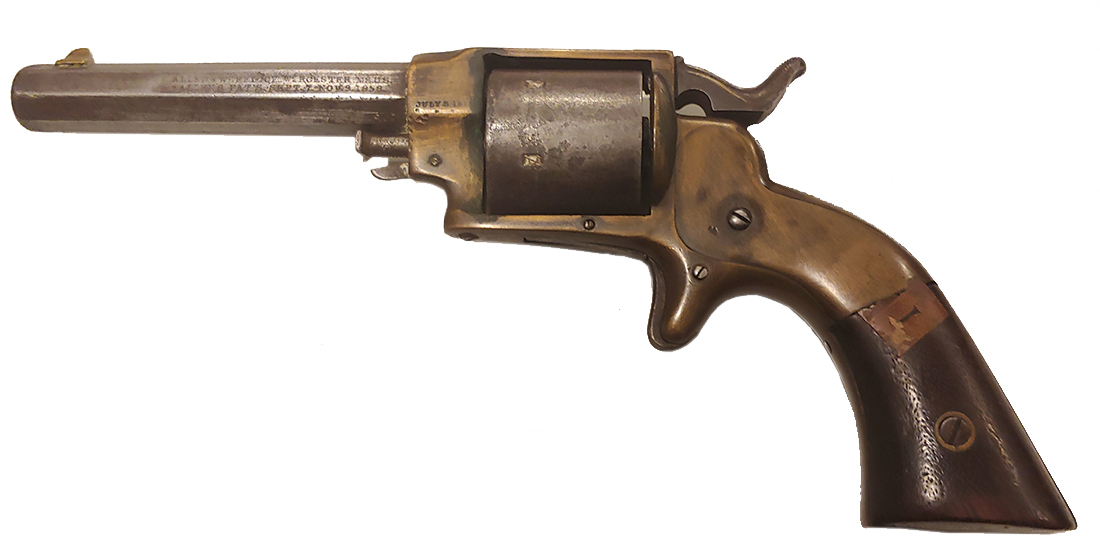
Sharps .32 caliber Pepperbox
20-01-21 Four shot .32 caliber rimfire Sharps Pepperbox in VG condition. 100% original, 100% complete, and mechanically perfect. Left frame marked C. SHARPS PATENT 1859. Traces of silver on the brass frame showing as black tarnish. Barrels are nicely patinated, no blue remains. Wood grips are also VG. A solid unmessed with Sharps. $595.00 SOLD

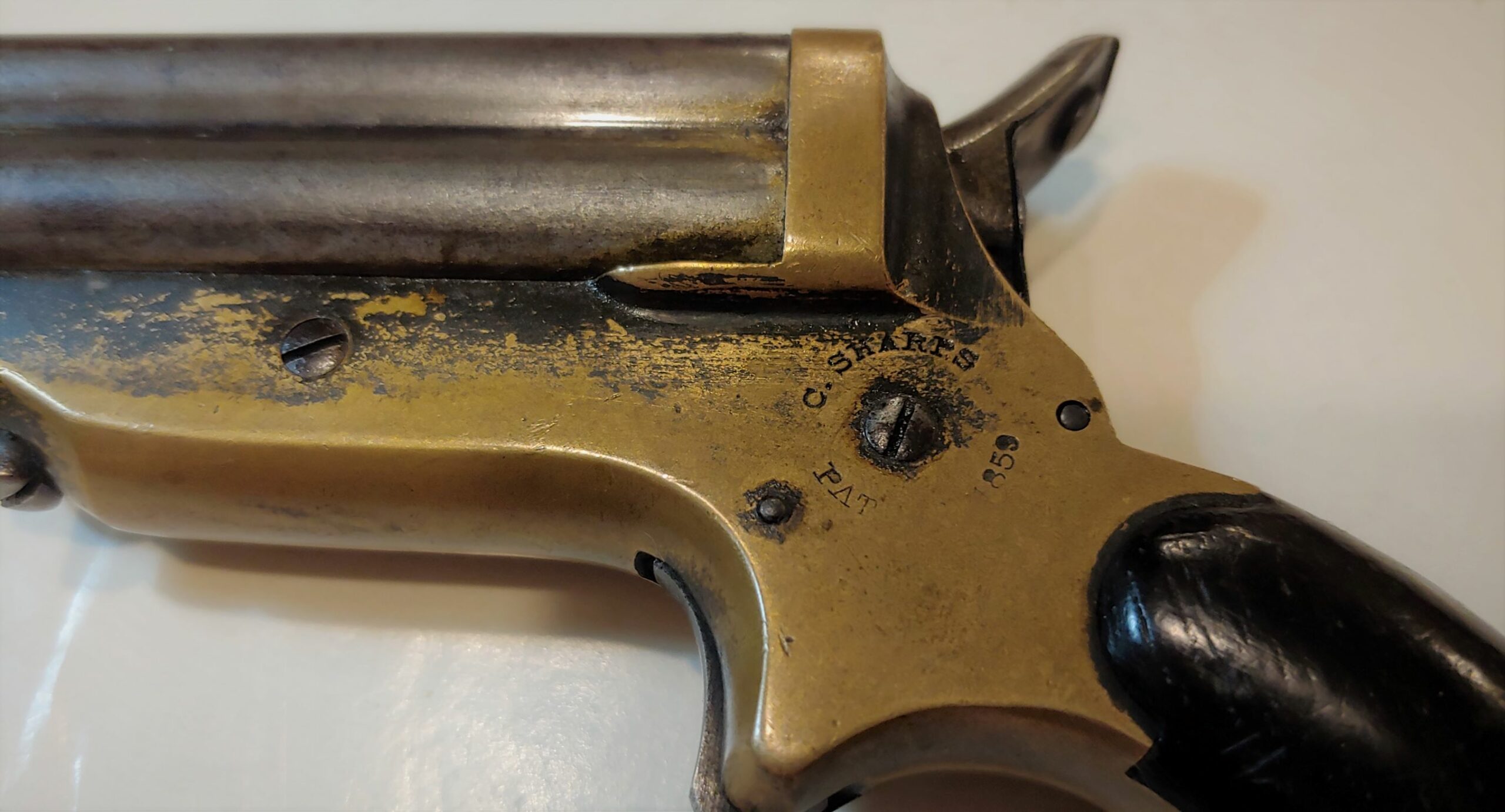


Pond Revolver w/ 6 Inch Barrel
20-01-22 SIX-INCH POND REVOLVER: DON’T MESS WITH SMITH AND WESSON! Smith and Wesson held the unique patent for a bored-through revolver cylinder, the most modern design at that time., and they were determined to defend their patent. In 1861 Lucius Pond of Worcester, Mass., somehow thought he could infringe on the patent and slip by unnoticed in producing several thousand of these .32 caliber rimfire revolvers in 4, 5 and 6-inch barrel lengths. He made them in brass and iron frame models. This is the iron-frame version of his revolver, with small release button on the lower left frame, enabling the barrel to swing up and the bored-through cyinder to be taken off for loading or removal of empty shells by sliding the chambers over the protruding pin under the barrel. Needless to say, this was rather similar to the Smith and Wesson revolvers and did not go unnoticed.
The grips are very good, with a little chipping at the edge of the square butt. This gun is complete except for the tiny hidden screwdriver that was screwed into the bottom of the butt strap and was concealed under the grips. As usual, it is not present. The metal is gray with a dusting of brown. The forward barrel is smooth, with just a few dings. The rear of the barrel shows corrosion from firing, a little more extensive on the right than the left, for an inch or two along the barrel and pin. The mechanics are good. The cylinder, hammer, frame, spur trigger, etc., are generally smooth metal, though there are some dings to the underside of the frame above the rear of the cylinder on the right.
Rimfire cartridge revolvers were resilient and resistant to moisture, and thus were a favorite for personal sidearms. We show a photo from an online source of a yankee soldier displaying one for the cameraman. Lucius Pond was right to use the system, but wrong to think Smith and Wesson would not care. They sued and won the case, obliging Pond to cease production and place additional markings on his remaining inventory. The barrel on this revolver bears Pond’s original barrel stamp: “L.W. Pond Worcester Mass. Patd. July 10 1860,” and also, “Manufd for Smith and Wesson Pat’d April 3 1855,” a nice warning for anyone else thinking of messing with the company. The money from the sale of these guns went to Smith and Wesson. $650.00 SOLD
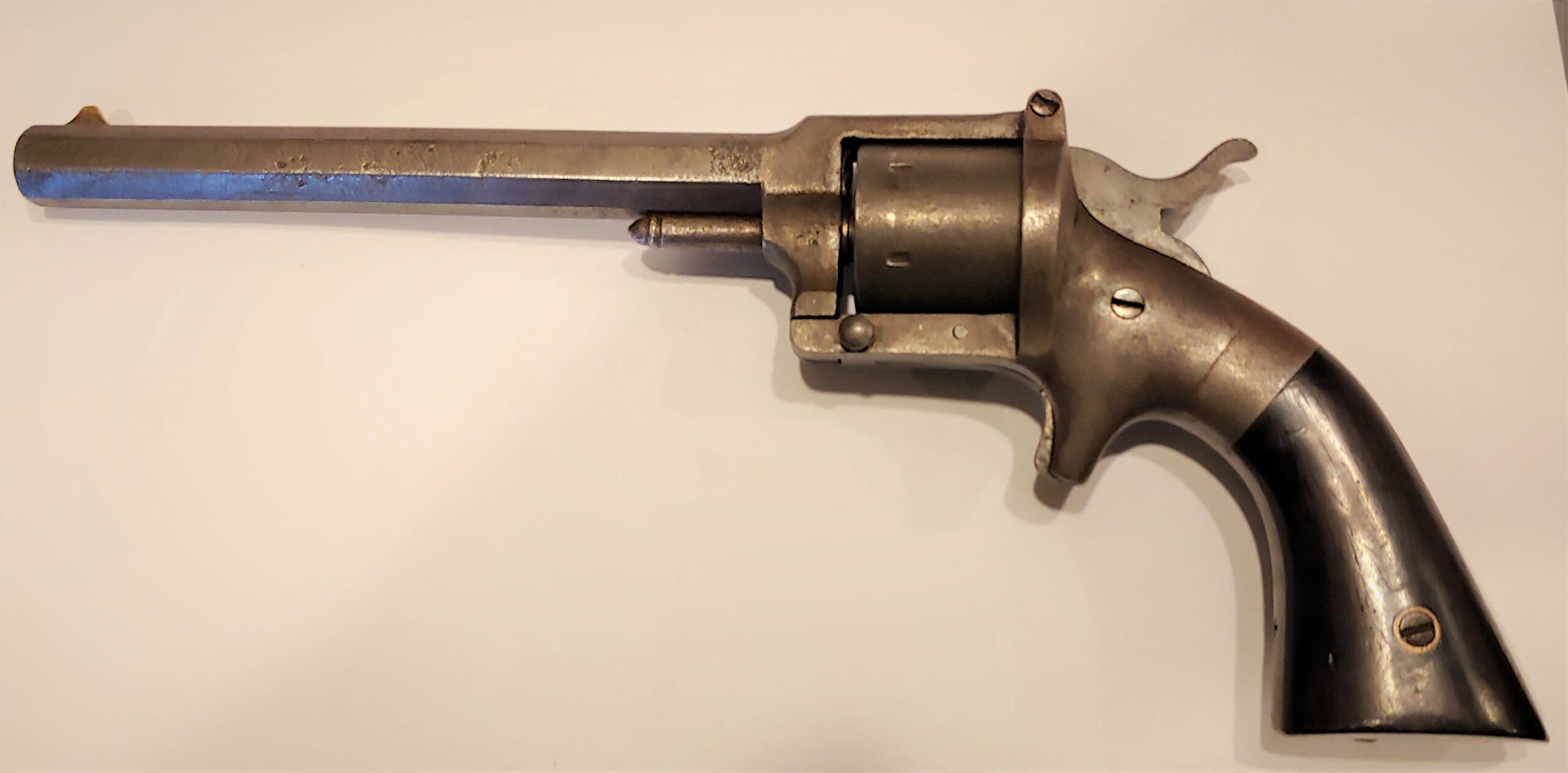
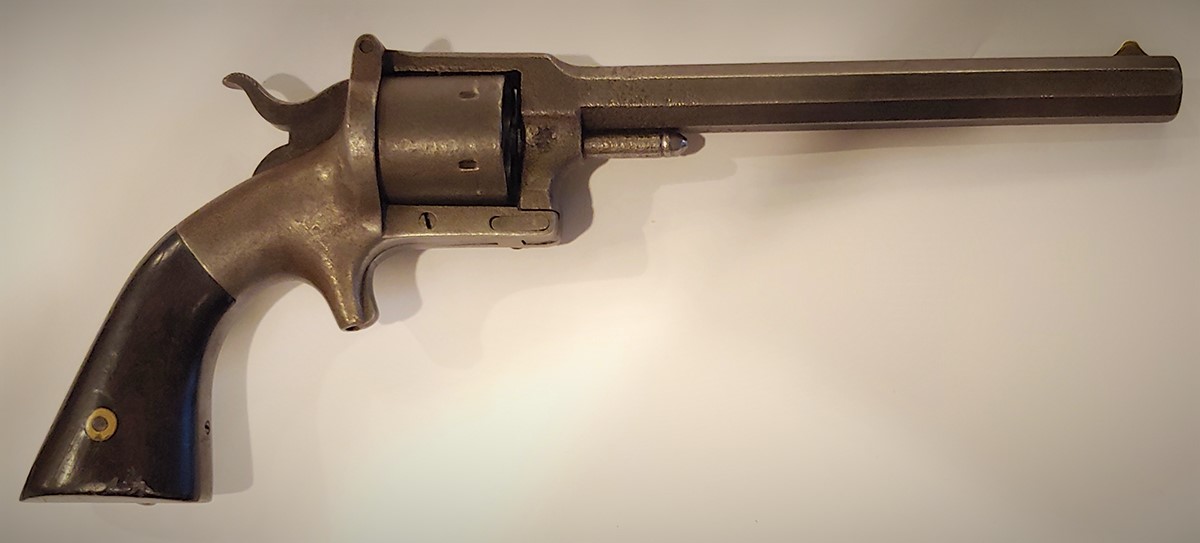
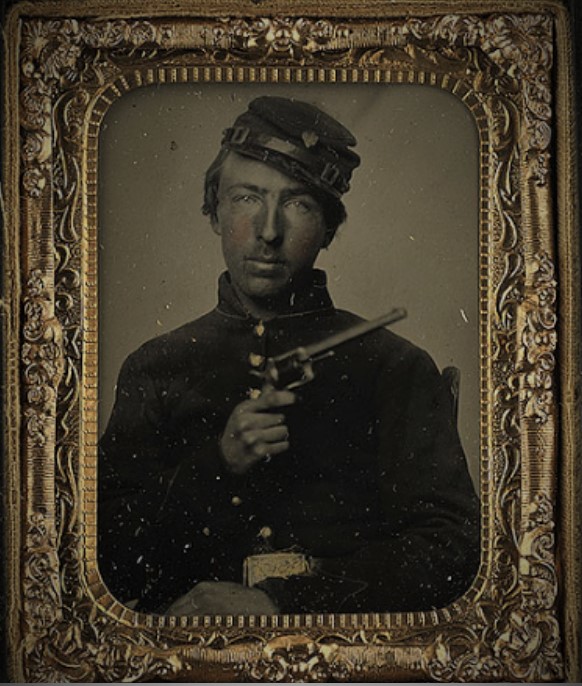
Union Soldier clearly displaying the same model Pond revolver with a six inch barrel. Shown as illustration only.



Extra Fine Quality English Flintlock Pistol / War of 1812 Era
20-01-23 A very fine quality early 19th century large bore flintlock belt or coat pistol. Roughly .56 caliber. 8 1/2 inches overall. 4 inch barrel. A hearty and beefy pistol showing the highest quality craftsmanship in terms of fit and finish, engraving and mechanics. The lock is nicely engraved with the maker’s name GILLET, and the barrel is engraved BRISTOL. The Gillet family of gun makers started as John and James Gillet of Bristol who opened the business in or before 1813 and ran it together until 1822. Shortly thereafter ownership devolved to James only. James Gillet continued making guns at 24 Clare Street in Bristol, England until 1840. See their trade card shown below. The quality of workmanship cannot be overstated. The wood to metal fit is perfect. The hand engraved steel surfaces are meticulously symmetrical, and very detailed. There is a sterling escutcheon plate on the wrist. All other furniture is patinated steel. Incredibly handsome. Overall fine condition. 100% original* 100% complete* and mechanically perfect. *The ash or hickory ramrod is likely a replacement, but fits perfectly and looks fine. The pictures below can describe this better than I can. A true work of art, 200 years old, and still cheaper than a mass produced percussion Colt revolver in similar condition. $1,450.00 SOLD

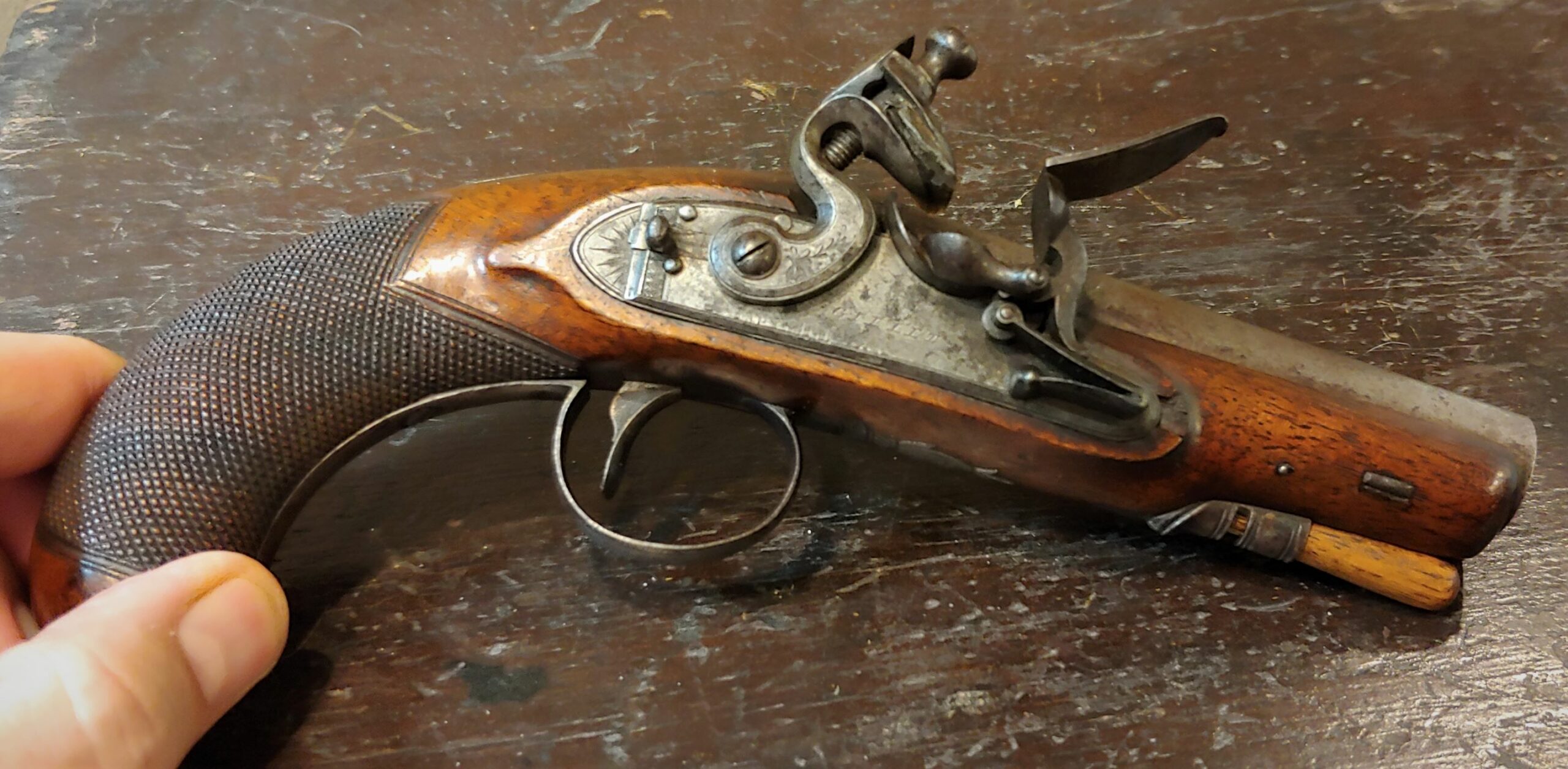


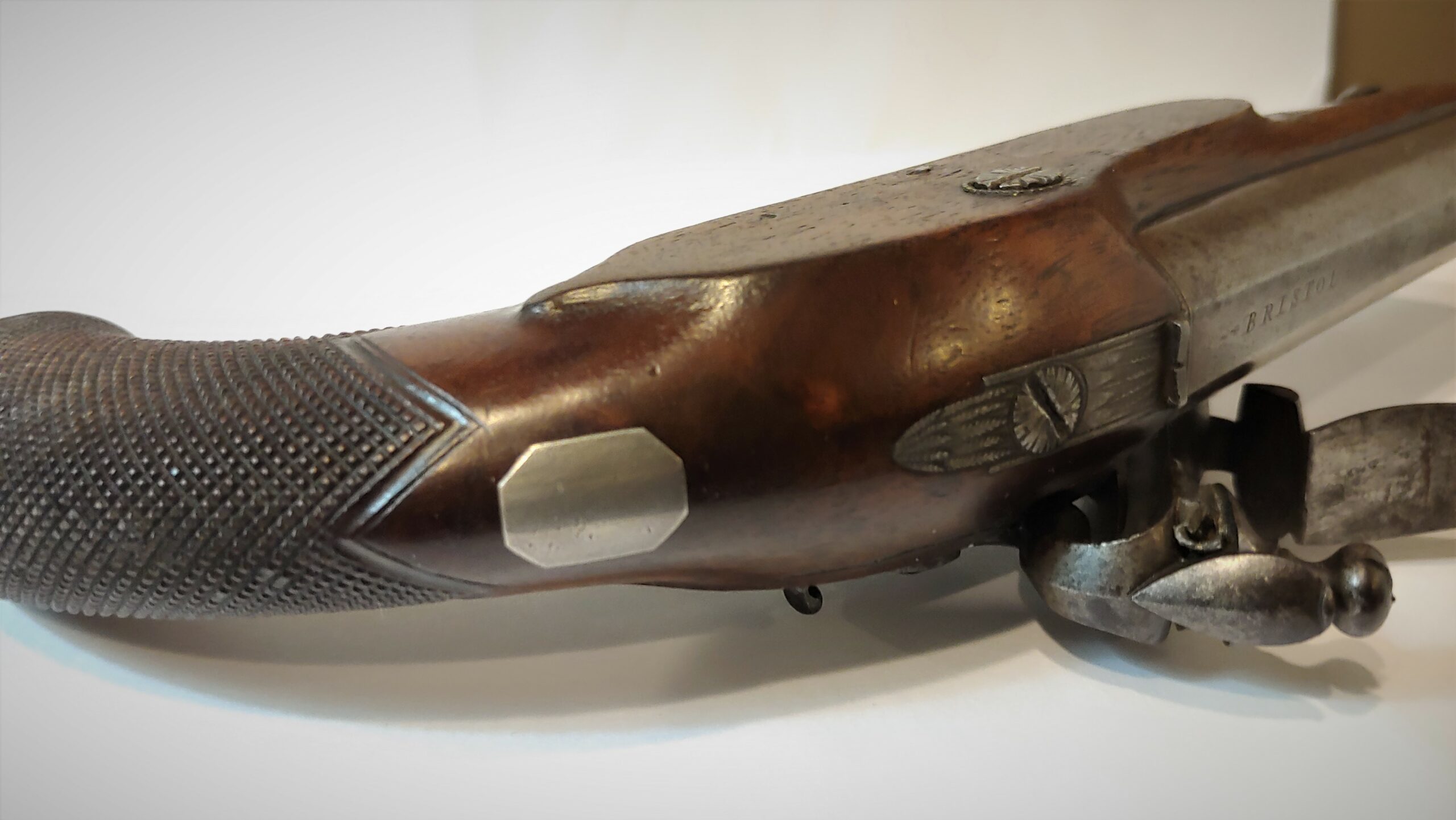
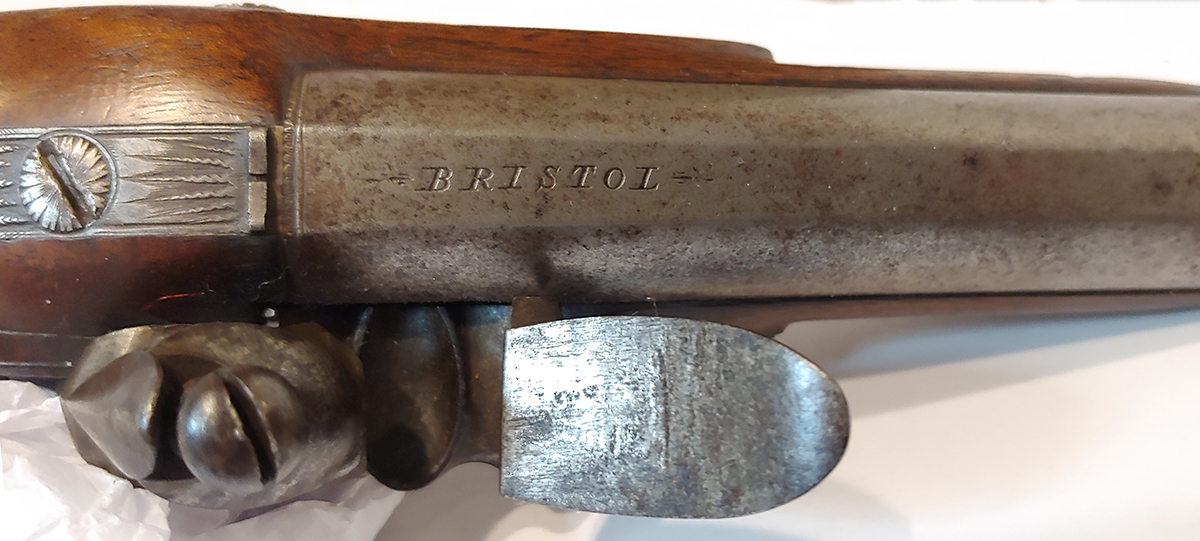
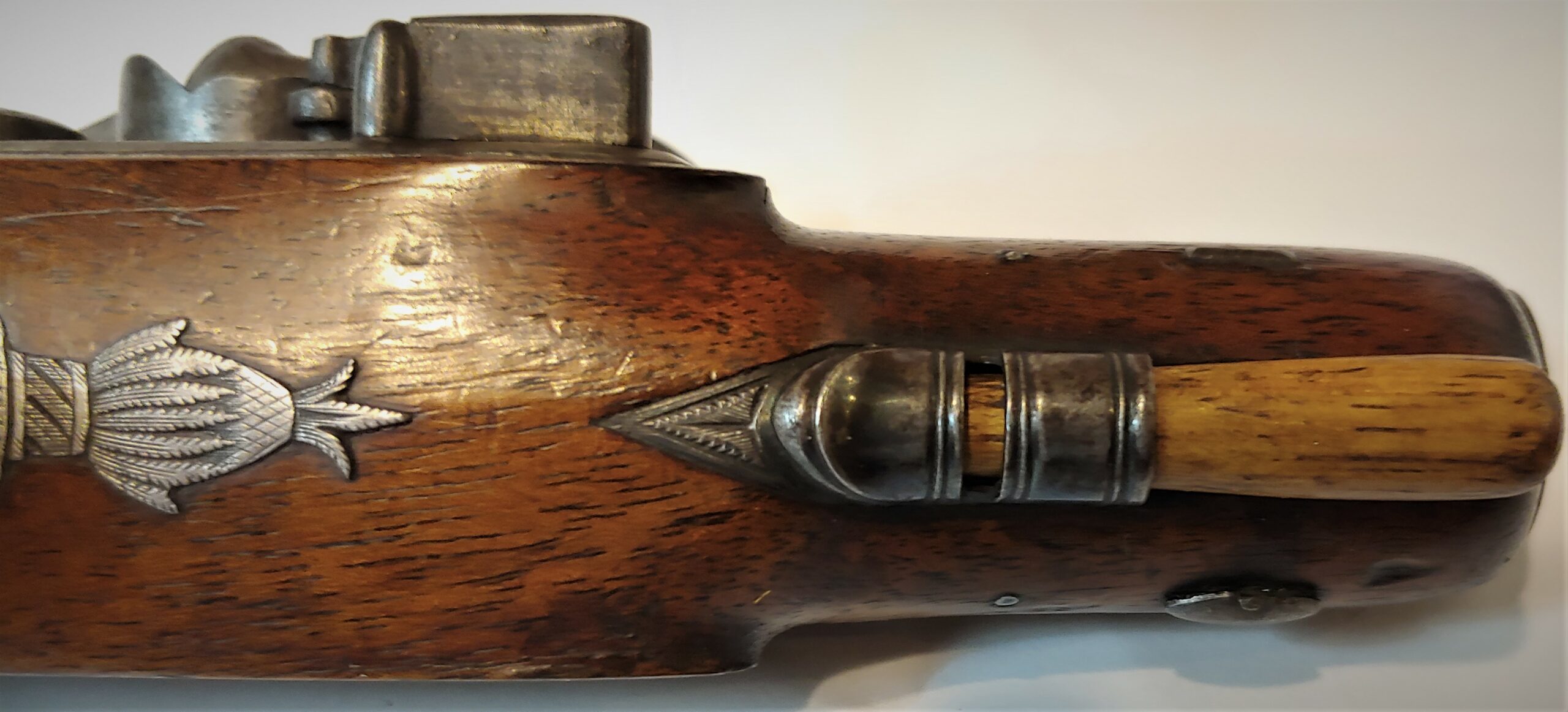

Freshly Found NCO or Cavalry Eagle Buckle
20-01-24 The descendants of the soldier brought this well worn eagle buckle into my shop last week. They have some buttons they have promised to send pictures of. This plate shows signs of LONG and continuous wear. During the Civil War and long afterward in my opinion. Very good condition with end of tongue chipped. El Cheapo $195.00 SOLD

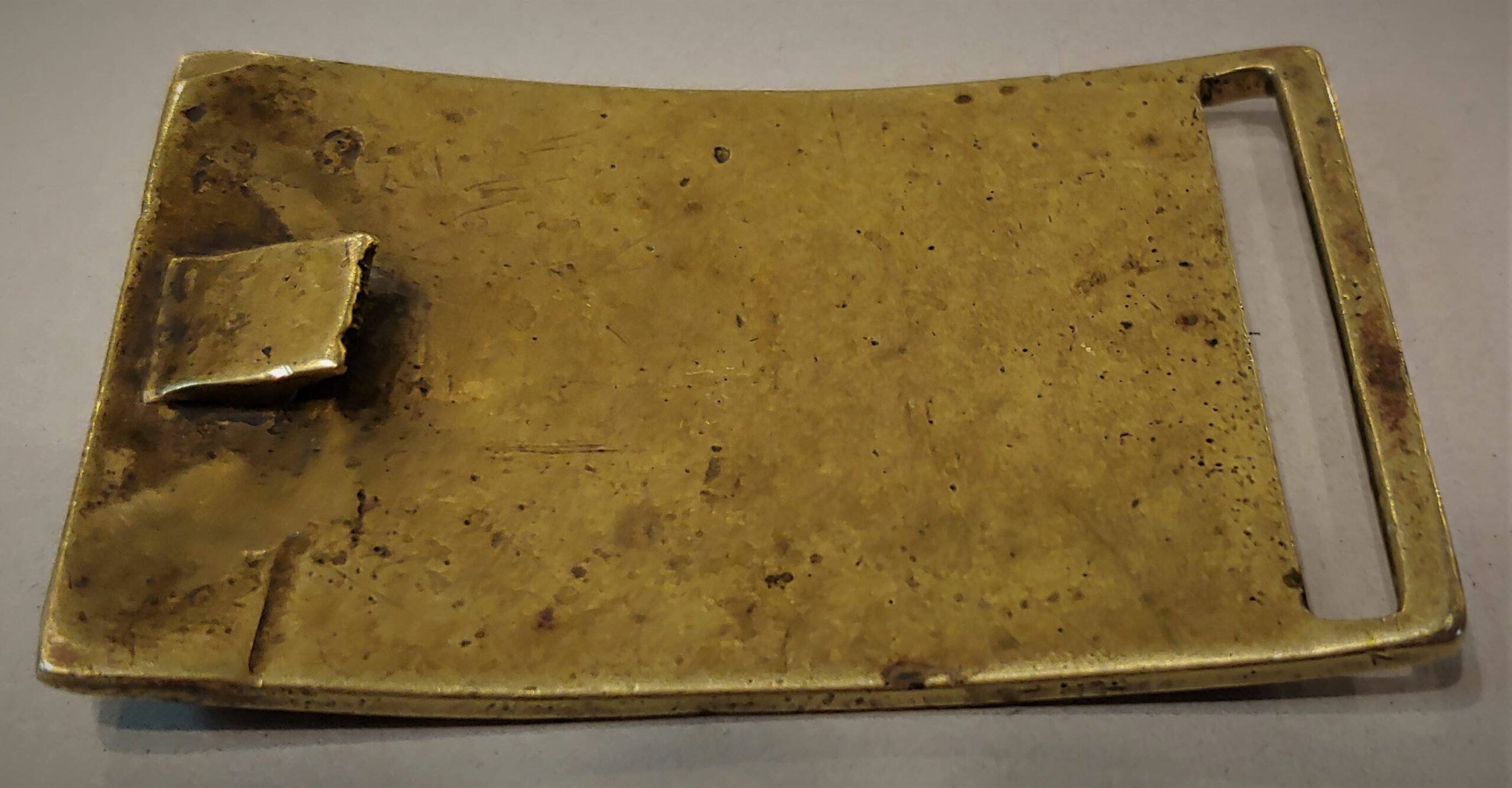
World War Two Theater Made Marine Combat Knife
20-01-25 This ferocious looking theater made World War Two knife is far more appealing than most of the crude aluminum and plastic handled knives we see at the militaria shows. The sweeping clipped point blade is made from a Japanese bayonet and is reminiscent of early 19th century blade styles. That is the reason I bought it. The handle is made of cast white metal. It is inscribed “Sgt. Reed 1943 US MC”. The brass pommel cap looks to have been commandeered from something else. My belief is that the knife was made for Sergeant Reed, and that the maker inscribed the handle for the sergeant. If Reed had inscribed the knife himself he would have included his first name or initials. I would think the maker made knives for other marines he knew. Perhaps you know of similar examples yourself. In the below photograph showing the men displaying captured jap flags the faces are hauntingly telling. I stared at those faces a good long time. Stoic, humorless, thousand yard stares, dirty, determined, undeterred, and tired. This simple old relic was there too. $165.00 SOLD

Superb Civil War Extra Rich Artillery Shoulder Straps.
20-01-26 All embroidered insignia is scarce. Artillery insignia is truly rare. And here we have a very large pair of artillery captain’s triple bullion border shoulder straps of the utmost quality. Most straps are single border design. Fancy expensive straps had two bullion borders. Here with have the elusive TRIPLE bullion border straps. $995.00 SOLD

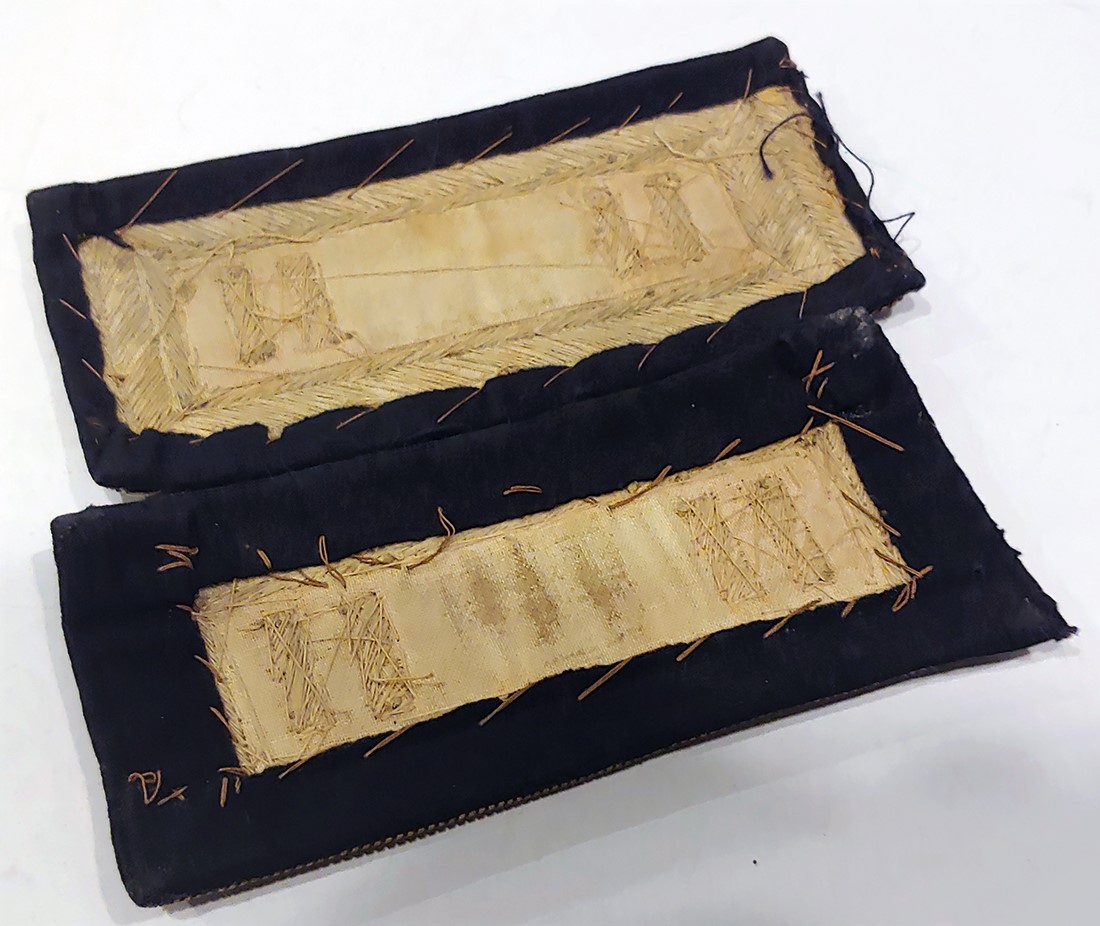
INGENIOUS REPAIR OF US BUCKLE w/ BELT
20-01-27 Note the repair on this early war stud back US oval buckle. The prong broke off and was repaired using a knapsack hook! How cool is that? Still on the brown leather US issue waist belt complete with the brass adjuster. When found the belt was broken. I had it professionally skived and repaired as shown. $295.00 SOLD

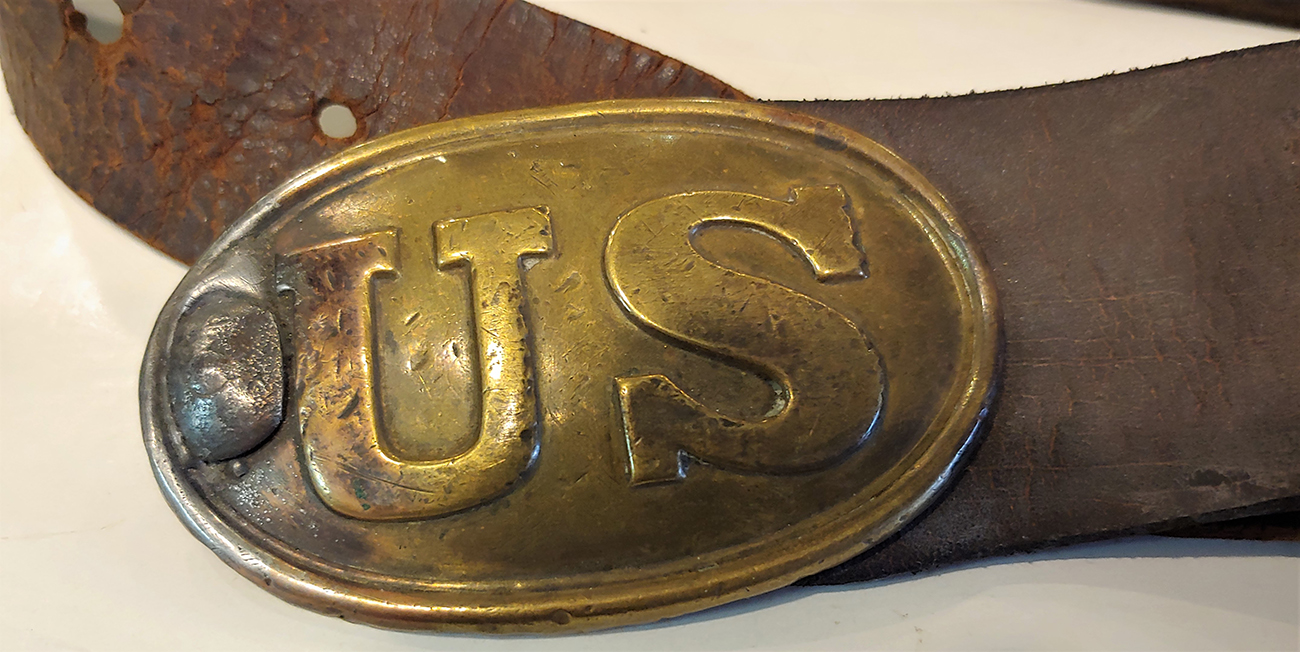
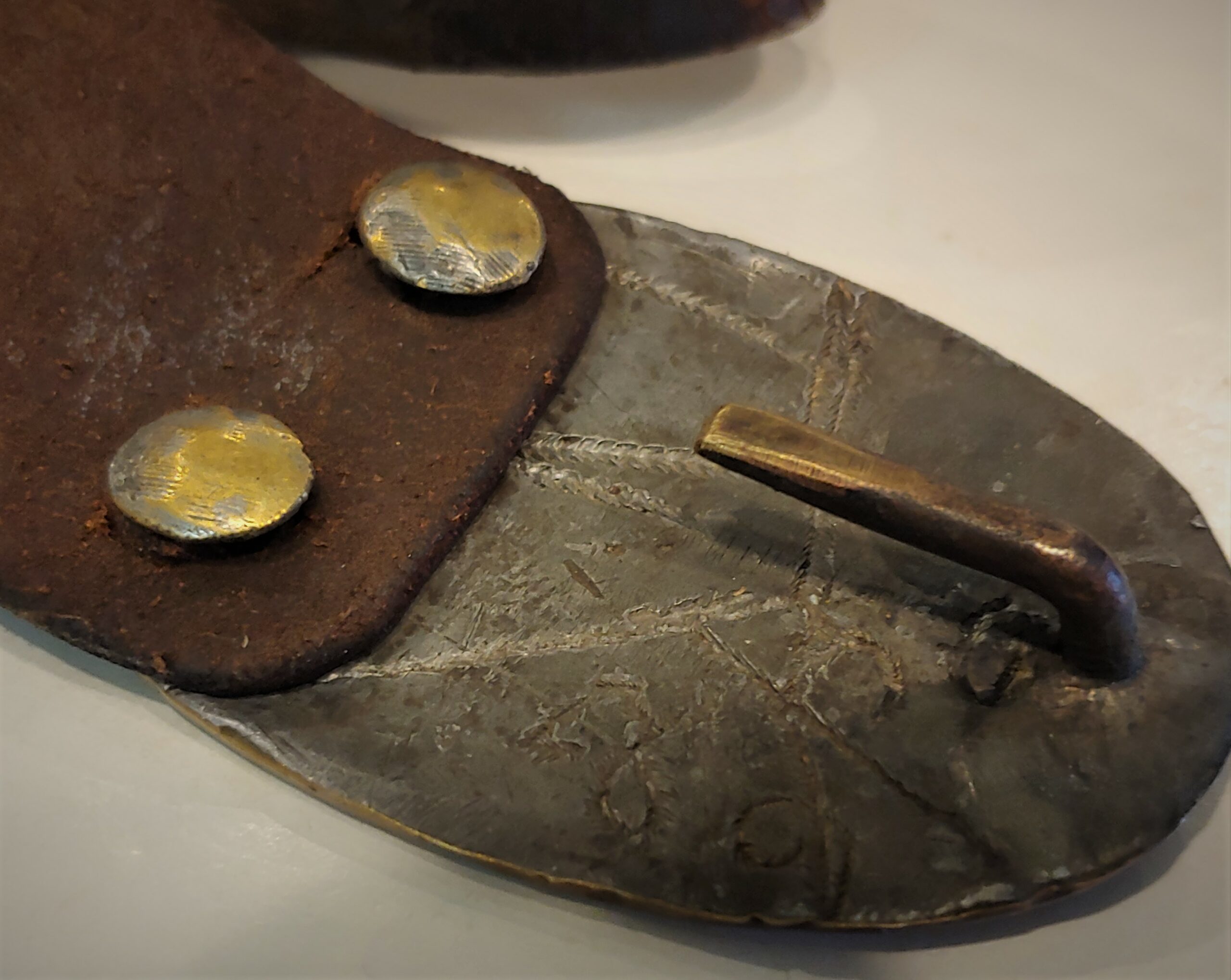

Layaways are Welcome
Need to split your order into multiple payments? No problem! A simple 20% earnest money deposit will hold your item for you.-acf
You can then pay it off in easy installments that fit your budget.
Read Terms Here
Items to Sell? Contact Us
I am always interested in buying ANYTHING from the American Civil War… Guns, Swords, Civil War Muskets, Knives, Uniforms, Flags, Medals, Badges, Diaries, Letters, Autographs, Buttons, photographs, tintypes, daguerreotypes, Insignia, Camp Items, Battlefield Relics, canteens, Drums, Etc… Call 419-842-1863 and ask for Dave Taylor.




